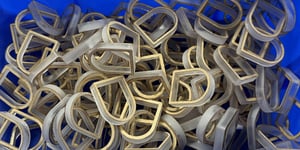For a moment, you might think there’s something wrong with your die cut quote: why does your unit price drop as the part quantity increases?
Part quantity often has an inversely proportional relationship with the unit cost of your product, meaning bulk orders could lower your price per part. Your part quantity's effect on your unit price depends on multiple factors, but primarily the value of your set-up cost.
Understanding the relationship between manufacturing price and quantity is an essential part of working with a converter, and it becomes less challenging once you’ve gained in-depth knowledge of converting costs or rotary die cut presses.
Strouse has dedicated more than three decades toward client education to inform our prospects about different aspects of the converting process because we believe in finding solutions that suit both our and our client’s industries.
We’ll go over the set-up and assembly, die cut production testing, and project run time for you to better understand converting costs and whether ordering a high part quantity is the right choice for you.
3 Reasons Higher Part Quantities Lead to a Lower Price Per Part
If you’ve already received a die cut converting quote for your project, you might have seen multiple options displayed under part quantity.
Your converter might show you quantity options to convey how larger orders can decrease the unit price. Rest assured, the price reduction isn’t just an attempt to reward you for buying more; it costs your converter proportionally less to set up for larger orders.
Fixed costs aren't affected by the quantity of your order, which is why larger quantity orders appear to have a better proportional value (more units for the same fixed cost). To demonstrate the relationship between part quantity and cost, we'll review the reasons why higher part quantities might reduce your price per part.
1. THE SET-UP AND ASSEMBLY PROCESS
Set-up and assembly are crucial steps to running parts on a machine press, but they result in multiple costs stemming from setup waste and labor time.
Material setup waste is a guaranteed part of die cut production testing, but as a result, you have to buy more material.
The cost of set-up and assembly is inevitable, but ordering in bulk allows some companies to pay less per part since the setup and assembly costs are a smaller percentage of the total.
Suppose a project’s set-up and assembly cost is $100/hr, it takes 5 hours of labor to do machine set-up, testing, and breakdown, and you can produce 1,000 parts per hour:
If you wanted a quote for 2,000 parts, you’d pay $500 in set-up/assembly costs and a machine run time cost of 2 hours.
However, if you ordered 10,000 parts, you’d pay $500 set-up plus 10 hours of run time. Your $500 of set-up costs would carry you further and could ultimately give you a lower unit price than if you placed smaller orders.
2. DIE CUT PRODUCTION TESTING
Die cut production testing occurs at the end of the press set-up to ensure converters made the right process adjustments and addressed any remaining issues with building functional parts out of materials.
When converters set-up your custom process, there are always process adjustments to make before your part meets the specifications and tolerances.
Die cut parts have specifications up to hundredths of an inch, and everything on the machine press must run smoothly to achieve these tight tolerances in rotary die cutting.
Whether you order a high or low volume of parts, the die cut production testing will be around the same length of time and cost. When you order higher volumes, you’re making the most out of your set-up, assembly, and die cut production testing time.
3. PROJECT RUN TIME
Your process is customized, and hasn’t been tested until we run your project. Depending on the project's complexity, setting up the machine press will take between a few hours and several days, which falls under the overall cost you’ll pay for labor time.
If it’s a new product for your converter, the only way to get final costing is to run a trial or run a production order with the idea that your price may change. Find out whether you should run a trial first:
Generally speaking, your final cost will have a better value if you order a larger quantity of parts, which is why you should consider scaling up your project quantity.
Orders of a greater quantity have longer project run times, which allows you to make more parts off the initial setup cost. For example, a project with a small volume might only run for 1 hour, while a larger project runs for 8 hours at the same set-up and assembly cost.
Will Ordering a Greater Quantity Offset My Production Costs?
Not everyone should order a greater quantity to try and offset their production costs.
While many big companies benefit from ordering in bulk, others might struggle to obtain the financial resources, storage space, or product demand necessary to succeed on large orders. Some companies can’t order in bulk due to specific concerns such as the adhesive shelf life.
Instead of ordering more parts, you could be better off consulting your project timeline to determine your ideal order size.
If you’re considering placing a purchase order, you might be interested in hearing what happens after you’ve placed it:






